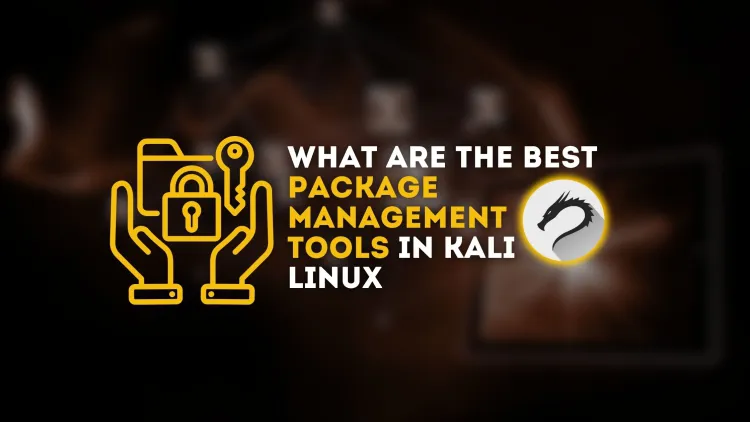How to Use APT, DPkg, Git, and Snap for Managing Tools in Kali Linux?The Best Tools for Penetration Testing
Managing packages efficiently in Kali Linux is essential for maintaining an updated and secure environment for cybersecurity tasks. The APT tool is the default for managing packages, while DPkg provides low-level management for .deb files. Git is essential for cloning repositories and staying up to date with the latest tools, while Snap ensures easy installation of cross-platform packages. Additionally, PPAs offer access to custom repositories and the latest software. Together, these tools make it easy to install, update, and manage the necessary tools for penetration testing and ethical hacking in Kali Linux.

Kali Linux is a powerful and flexible operating system designed for cybersecurity professionals, penetration testers, and ethical hackers. One of its strengths is the robust set of tools available for performing security assessments. However, managing these tools efficiently is just as important as using them. This is where package management tools come into play.
Package management tools are used to install, update, and remove software packages on a Linux distribution. In Kali Linux, where continuous testing and auditing tools are vital, package management tools help ensure that you have access to the latest versions and security patches. In this blog, we will explore the best package management tools in Kali Linux and how they simplify the installation and maintenance of your cybersecurity toolkit.
1. APT (Advanced Package Tool)
What is APT?
APT is the default package management system in Kali Linux. It’s a robust tool that handles the installation, upgrading, and removal of software packages. APT works with DEB files (Debian packages) and uses repositories to manage packages.
How Does APT Work?
APT works with a repository of precompiled packages, typically located on official or third-party servers. When you install a package, APT downloads it from the repository and resolves dependencies (other packages that are required for proper functionality).
Key Commands for APT:
-
Update Package Lists:
This command updates the list of available packages and their versions, ensuring that you install the latest version of any tool.
-
Install a Package:
For example, to install Nmap, use:
-
Upgrade All Packages:
-
Remove a Package:
Why Use APT?
- User-Friendly: Easy to use with simple commands.
- Automatic Dependency Resolution: Automatically installs dependencies when you install a package.
- Large Repository Support: Access to thousands of packages.
2. DPkg (Debian Package Manager)
What is DPkg?
DPkg is the low-level package management tool used by Debian-based distributions (including Kali Linux). While APT is often used for package management, DPkg is responsible for the installation, removal, and querying of .deb packages directly.
How Does DPkg Work?
DPkg installs and manages individual .deb files, bypassing the need for repositories. While APT fetches packages from repositories, DPkg is used when you have a local .deb file.
Key Commands for DPkg:
-
Install a Package from a .deb File:
-
Remove a Package:
-
Check for Missing Dependencies:
Why Use DPkg?
- Direct Installation: Useful for installing packages from local
.debfiles. - Faster Installation: Ideal for quick installs when you already have the package file.
3. Git
What is Git?
While Git is not traditionally a package management tool, it’s an essential tool in Kali Linux, especially for cybersecurity professionals and ethical hackers. Git is a version control system widely used for managing source code and can be used to clone, download, and manage tools directly from Git repositories.
How Does Git Work?
You can use Git to clone repositories and get the latest updates for security tools. Git allows you to contribute to open-source projects and track updates to cybersecurity tools.
Key Commands for Git:
-
Clone a Repository:
-
Pull Latest Changes from a Repository:
-
Check the Current Branch:
Why Use Git?
- Access to Latest Versions: Git provides direct access to the latest versions of tools.
- Open-Source Collaboration: Contribute to and collaborate on open-source penetration testing tools.
- Version Control: Keep track of tool changes and updates.
4. Snap (Snap Packages)
What is Snap?
Snap is a package management system developed by Canonical, the makers of Ubuntu. Snap packages are universal Linux packages that can be installed on any distribution, including Kali Linux. Snap packages contain all necessary dependencies, making them easy to install without worrying about missing libraries.
How Does Snap Work?
Snap packages are isolated from the rest of the system, ensuring that they don’t interfere with other applications. You can install Snap packages using the Snap Store or by using commands in the terminal.
Key Commands for Snap:
-
Install a Snap Package:
-
List Installed Snap Packages:
-
Remove a Snap Package:
Why Use Snap?
- Cross-Platform Support: Works across various Linux distributions.
- Containerized Packages: Snap packages are self-contained, making them easy to install.
- Automatic Updates: Snap packages automatically update, ensuring you always have the latest versions.
5. PPA (Personal Package Archives)
What is PPA?
A PPA is a software repository created and maintained by individual developers or groups. PPAs are commonly used in Ubuntu-based distributions, but Kali Linux can also add PPAs to install additional tools that may not be available in the default Kali repositories.
How Does PPA Work?
You add a PPA to your system using the add-apt-repository command and then install packages as you would from any other repository.
Key Commands for PPA:
-
Add a PPA Repository:
-
Update Package List:
-
Install Packages from PPA:
Why Use PPA?
- Access to Latest Software: PPAs often provide the most up-to-date versions of software.
- Custom Repositories: Easily add custom or third-party repositories to Kali Linux.
Conclusion
Kali Linux provides a variety of package management tools to handle the installation and maintenance of the software and tools used in cybersecurity and penetration testing. APT is the primary tool for managing software packages, while DPkg is used for managing .deb files directly. Git allows you to download and contribute to open-source repositories, and Snap simplifies installation with universal package formats. By understanding and utilizing these tools, you can ensure that your Kali Linux system remains up to date and secure, with access to the latest security tools and features.
FAQs
-
What is the primary package management tool in Kali Linux?
- APT (Advanced Package Tool) is the primary package management tool in Kali Linux. It allows you to install, upgrade, and remove software packages from repositories.
-
How do I install software using APT in Kali Linux?
- To install a software package using APT, run: For example, to install Nmap, you would type:
-
What is DPkg and how does it differ from APT?
- DPkg is a lower-level package manager used to handle
.debfiles directly, whereas APT works with repositories and automatically resolves dependencies. DPkg is typically used for local package installations.
- DPkg is a lower-level package manager used to handle
-
Can I install software from Git repositories in Kali Linux?
- Yes, Git allows you to clone repositories directly to your system and is frequently used for downloading the latest versions of cybersecurity tools, often from GitHub or other repositories.
-
How do I manage Snap packages in Kali Linux?
- To manage Snap packages, use the
snapcommand. For example, to install a Snap package, run:
- To manage Snap packages, use the
-
What is a PPA in Kali Linux and how do I use it?
- A PPA (Personal Package Archive) is a repository maintained by third-party developers. You can add a PPA to Kali Linux and install packages not found in the official repositories. To add a PPA, use:
-
What are the benefits of using Snap over traditional package managers?
- Snap packages are self-contained, meaning they include all necessary dependencies. They also have automatic updates and work across different Linux distributions, not just Kali Linux.
-
How do I ensure that my Kali Linux system remains up to date with security patches?
- Regularly update your system using the following commands:
-
How do I uninstall a package in Kali Linux?
- To remove a package installed via APT, use: For Snap packages, use:
-
Can I manage local
.debpackages in Kali Linux?
- Yes, you can use DPkg to manage local
.debpackages. To install a.debpackage, run:











![Top 10 Ethical Hackers in the World [2025]](https://www.webasha.com/blog/uploads/images/202408/image_100x75_66c2f983c207b.webp)



![[2025] Top 100+ VAPT Interview Questions and Answers](https://www.webasha.com/blog/uploads/images/image_100x75_6512b1e4b64f7.jpg)







